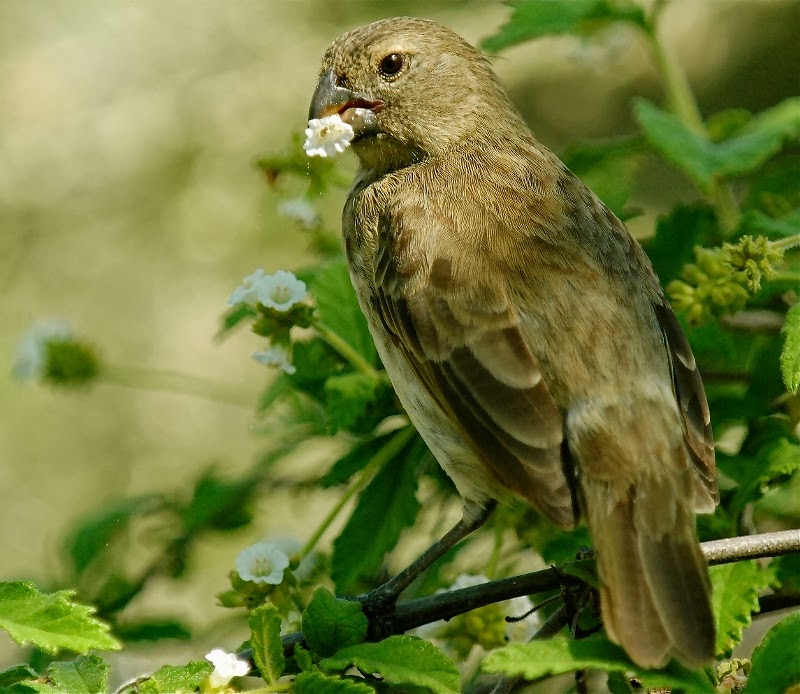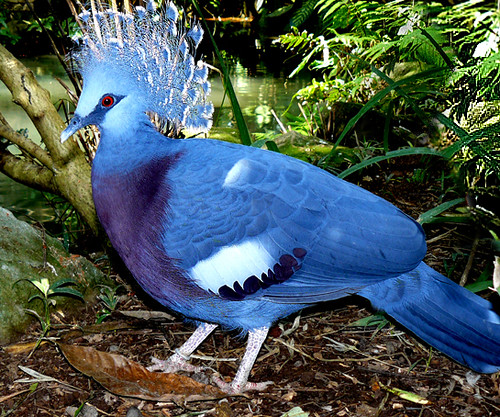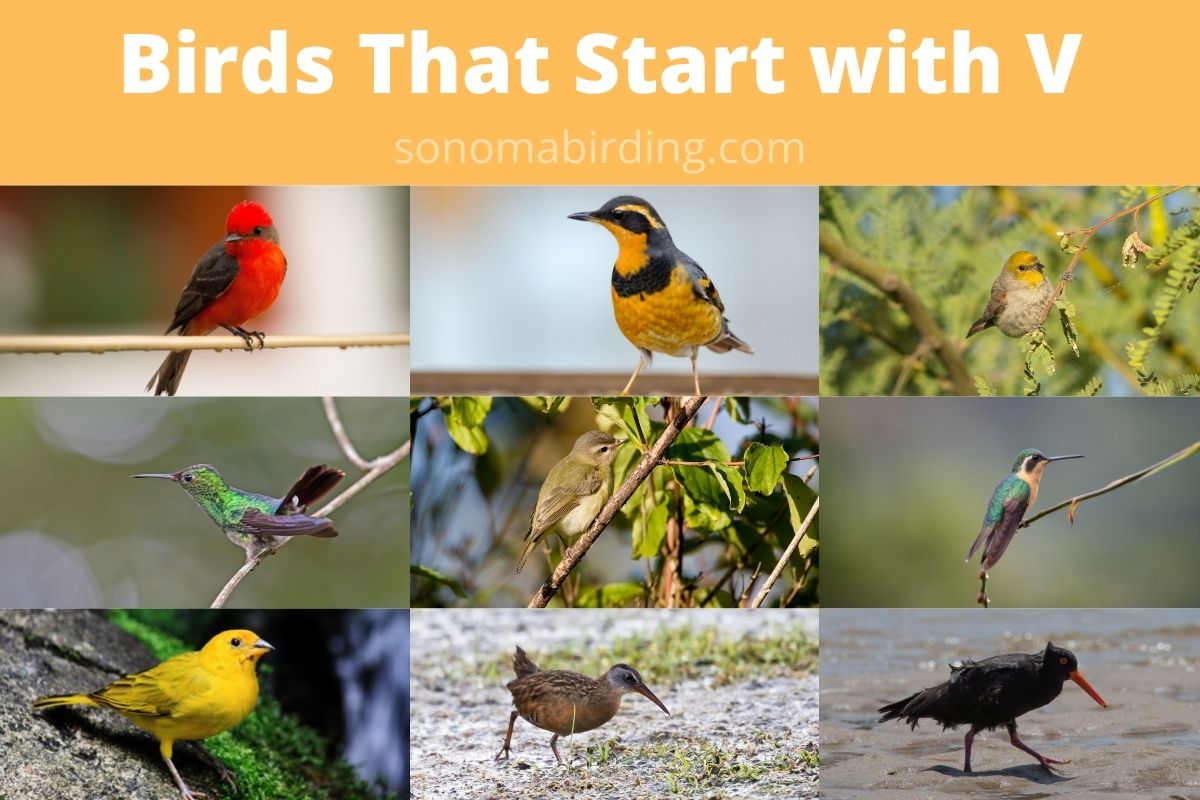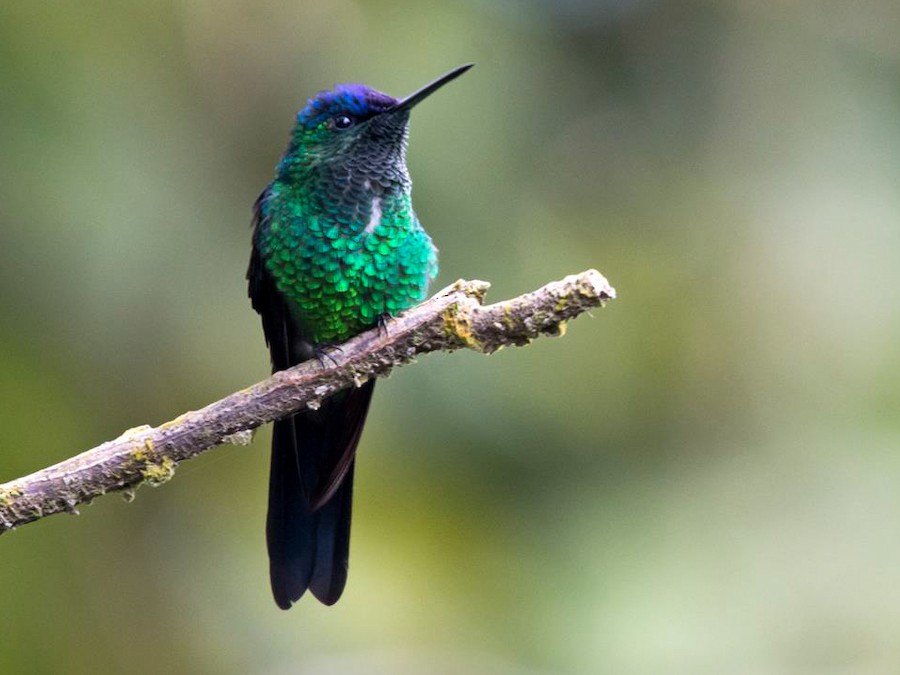Today in our office we had a rather strange but fun conversation about birds that begin with the letter V. V…V…V…V… It’s on my mind. Most people know Vulture, Vice, Vixen but what are some other birds that start with V?
I am sure after reading this post you will agree when I say that there are plenty of interesting birds out there with the letter V in their name. The variety of birds on this list is truly impressive. When I see a list like this it makes me think about how awesome some of these birds are, and how they have one of the best sounding names in the animal kingdom.
Velvet Scoter (Melanitta fusca)
Velvet Scoters are large ducks endemic to North America and East Siberia. These migratory ducks spend their winter in southern temperate zones and the northern coast of Europe.
Velvet Scoters have a voluminous body and a large bill. Except for the white patch around their eyes, males are fully black. Their bill is yellow, having a blackish base. Their female counterparts are mainly brown with white wing patches and light spots on each side of their head.
Vermilion Flycatcher (Pyrocephalus obscurus)

Vermilion Flycatchers are tiny passerine birds found in North and South America. These birds breed across open areas, agricultural lands, Savana scrubs, and riparian woodlands.
Their North American population is mostly resident, while the South American population migrates far to the northernmost sections of the Brazilian Amazon.
Vermilion Flycatchers are strongly sexually dimorphic. The males have a vibrant red body and a dark brown plumage. They have red underparts, crowns, and chests. Their upperparts are between brown and blackish brown.
On the other hand, their female counterparts have a peach-colored belly with dark grey upper parts. Their underparts start in white, taking a reddish turn downwards.
Varied Thrush (Ixoreus naevius)

Varied Thrushes are migratory birds found across the western United States. Their natural habitats include older coniferous forests, orchards, and thickets.
Varied Thrushes feature deep orange and black feathers. The males have curved grey patterns on their breast and throat, with their greyish-blue crown, scruffs, and tail end. Legs are mostly dark brown or tawny.
The females are olive-brown colored, having brown hind feathers and greyish-brown plumage near the breast. These birds are mainly insectivorous but prefer having fruits and seeds in the winter.
Variable Goshawk (Accipiter hiogaster)
Variable Goshawks are a raptor species endemic to Indonesia. Their natural habitats include forest borders in the lowlands and foothills, and tropical mangrove vegetation.
Variable Goshawks are medium-sized raptors featuring slate-grey upperparts and rufous toned underparts. These birds closely resemble Brown Goshawks and Collared Sparrowhawks but are larger than both species.
Violet-Capped Hummingbird (Goldmania violiceps)
Violet-Capped Hummingbirds are a near-threatened hummingbird species found in Central and South America. These birds inhabit tropical moist lowland forests.
The adult Violet-Capped Hummingbirds are strongly sexually dimorphic. The males have a polished emerald-green body complemented with a glossy purple crown and smooth purple tail.
The females, on the other hand, have whitish underparts with green marks on the sides. Their tail is immersed in chestnut. Violet-Capped Hummingbirds prefer feeding on flowers at low to middle elevations.
Variable Hawk (Geranoaetus polyosoma)

Variable Hawks are birds of prey widely distributed in western and southern South America. Their common habitats include coastal foothills of the Pacific, Patagonian Steppes, beechwood river galleries borders, and agricultural areas.
As the name suggests, both sexes of Variable Hawks occur in several morphs. They have a white tail and grey wings. The color of the remaining plumage varies anywhere from deep grey to whitish.
Female Variable Hawks have a reddish-brown back, normally lacking in males.
Vermilion Tanager (Calocuaetes coccineus)
Being the monotypic member of the Calocuaetes genus, the Vermilion Tanagers are a South American tanager species that inhabit tropical or subtropical moist montane forests.
Vermillion Tanagers have a vibrant red body with black wings, throat, and face. Both sexes of adults are sexually monomorphic.
These birds have a deep black bill. They mostly resemble Masked Crimson Tanagers but lack their black belly. Insects, honey bees, beetles, crickets form their chief means of diet.
Vervain Hummingbird (Mellisuga minima)
Vervain Hummingbirds are non-migratory hummingbirds native to the Caribbean Islands. Their natural habitats include evergreen forests, gardens, desert shrub-scrub, and dense urban environments. Though non-migratory, seasonal movements have been noticed due to food shortage.
Vervain Hummingbirds are tiny-sized birds with dull black bills and dark-brown eyes. Their legs and feet are typically dusky in appearance. Both sexes have little physical differences. Their upper plumages are dark metallic.
The males have completely dark and slightly forked tails. In females, the tail is rounded, and outer flight feathers are white-tipped.
Verdin (Auriparus flaviceps)

Verdins are a tiny penduline tit species endemic to North America. These birds inhabit shrubs and thorny thickets with few trees.
Verdins have a greyish appearance, pale plumage, and their head is bright yellow. Their rufus shoulder patches and sharply pointed bills are the other characteristics of these birds.
Verdins are insectivorous and prefer catching their prey among the scrubs and desert trees. They also eat fruits, berries, and often nectars obtained from hummingbird feeders.
Volcano Junco (Junco vulcani)
Volcano Juncos are tiny sparrows native to Central America. These birds inhabit open grassy lands or shrubby areas at higher elevations.
Volcano Juncos have a demonic look that features distinctive yellow eyes, in sharp contrast to their black face. Their bill is pale pink. Overall, they have a greyish appearance with a brownish back and black streaks all along.
These birds prefer having an omnivorous diet that includes seeds and insects. However, during the breeding season, they feed on insects exclusively.
Volcano Hummingbird (Selasphorus flammula)

Volcano Hummingbirds are tiny South American hummingbirds that inhabit elfin forests at higher altitudes. They breed across open areas with flowers.
The male Volcano Hummingbirds have bronze-green upper parts, and their black outer tail feathers are bordered with chestnut. The throat color varies according to the range. Though similar in appearance, their female counterparts have white throats with dusky patches.
Vega Gull (Larus vegas)

Also referred to as “East Siberian Gull,” the Vega Gulls are large migratory gulls that are endemic to northeast Asia. Harbors across the rocky shores or river mouths are their natural habitats.
The head of Vega Gulls is smudged with brown in winter, along with their neck, side, and back. Their bill is yellow with a red mark. Though the color of their eyes varies, they are mostly dark with red orbital rings.
Vesper Sparrow (Pooecetes gramineus)

Being the monotypic member of the Pooecetes genus, the Vesper Sparrows are a New World Sparrow species. They are common across the Northern United States and Canada.
These birds inhabit dry grasslands at lower elevations. These migratory birds breed in the open bushy areas of North America and spend the winters in the eastern and central United States.
Vesper Sparrows feature brown upperparts and paler underparts with dark streaking overall. Their eyes are surrounded by tiny white rings. Their shoulders consist of a chestnut mark. Both sexes appear similar and are monomorphic.
Virginia’s Warbler (Leiothlypis virginiae)

Virginia’s Warblers are small birds common across the western and southwestern United States. These birds inhabit dense oak, and pinyon woodlands are the natural habitats. They are named after Virginia Anderson, who discovered them in New Mexico in 1858.
Virginia’s Warblers have a small body covered overall in grey, with white eye-rings. Their rump and under tail coverts are yellow, while the underparts are lighter. They have yellow marks on their breast and a mostly hidden, polished-red crest.
Violet Cuckoo (Chrysococcyx xanthorhynchus)

Violet Cuckoos are a partially migratory cuckoo species native to southeast Asia. They inhabit tropical and subtropical moist lowlands. Though their southern population is resident, the northern population tends to be migratory.
Violet Cuckoos are sexually dimorphic. The males have polished violet feathers on the head and upper parts of the body. Their black tail is tipped with white, with a white belly being tossed with green, broad black, and violet lines.
The female Violet Cuckoos are characterized by deep brown crowns and greenish-bronze upperparts. Their eyes and forehead are featured by white markings. Their breast is colored in bronze-green and marked by chestnut lines.
Village Weaver (Ploceus cucullatus)
Village Weavers, also addressed as “Black-Headed Weavers,” are stocky weaver species that are endemic to sub-Saharan Africa. They inhabit semi-open habitats that include woodlands and human habitation.
The adult Village Weavers display sexual dimorphism, particularly in the breeding season.
The breeding males have a black conical bill, reddish eyes, black and yellow underparts, and wings.
The non-breeding males consist of yellow heads with olive crowns, grey upper portions, and white underparts. The females are colored similarly, having olive upperparts and light yellow underparts with yellow and black wings.
Virginia Rail (Rallus limicola)
The Virginia Rails are tiny waterbirds belonging to central and South America. These rails inhabit freshwater and breed across the marshes.
Virginia Rails have an overall brown body with a long reddish bill, grey cheeks, and a white throat. The upper part of their eye is marked by a red stripe, with orangish-brown legs.
In order to walk easily on the floating vegetations, Virginia Rails have long toes, a laterally compressed body, and efficient forehead feathers.
The main diet of Virginia Rails includes aquatic animals and insects like frogs, beetles, flies, dragonflies, small snakes, fish, and even seeds.
Varied Tit (Sittiparus varius)

The Varied Tits are tiny perching birds native to East Asian regions of Korea, Japan, northeastern China, and southeastern Russia. These birds inhabit open mixed forests, coniferous forests with Japanese yews, pines, and bamboo forests at river valleys.
Varied Tits are characterized by their black crown, bill, throat, upper breast, and nape. Their face, forehead, and cheeks have a whitish texture, while their back, tail, and wings are bluish-grey in appearance. Both sexes appear similar, displaying sexual monomorphism.
These birds mainly feed on seeds and insects such as caterpillars.
Vampire Ground Finch (Geospiza septentrionalis)

The Vampire Ground Finches are tiny finches that are endemic to the islands of the Galapagos. These birds prefer to inhabit deciduous forests and low vegetation areas. Their population is currently listed as a Vulnerable Species by the IUCN.
Vampire Ground Finches are small, sharp-billed birds that are widely sexually dimorphic. Among their subspecies, they have evolved the largest bill.
The males have a black bill and soot-colored plumage. Their female counterparts have a dull orange bill, a brown plumage, and grey streaks on their lower body. These finches peck at the bases of boobies to draw blood to feed on.
Variable Oystercatcher (Haematopus unicolor)’
The Variable Oystercatchers are large waders endemic to New Zealand. They breed on sandy places like beaches, coasts of lakes and avoid gravel beaches.
Since Variable Oystercatchers are polymorphic, they vary in color ranging from black to pied. Oystercatchers from the north are more whitish than Southern all-black Oystercatchers. They have pinkish legs, red iris, orange beaks, and eye rings. Their thin needle-like bill darkens in color during the breeding season. They have slight body dimorphism as females are larger than males.
Varied Bunting (Passerina versicolor)
Found in the south of North America and Mexico, the Varied Buntings are tiny songbirds that live in thorny canyons, deserts, scrubby woodlands, and stream corridors.
Varied Buntings are small delicate birds that have a shallow, forked tail and a short bill. The adults are strongly sexually dimorphic, with the males having a crimson head with a violet-blue face.
The females are mainly brown with grey, un-streaked underparts. Both sexes have a rounded bill.
Violet- Green Swallow (Tachycineta thalassina)
The Violet-green Swallows are insectivore birds that are found in North America. They breed in coniferous and deciduous forests and cracks of cliffs.
Violet-Green Swallows are sleek birds that show slight sexual dimorphism. The males have cheek patches, and their female counterparts have dusky cheeks.
All adults have a green-bronze back with hints of violet and crisp white bellies. Their population is slightly vulnerable to climate change but is still found abundantly.
Vegetarian Finch (Platyspiza crassirostris)

Endemic to Galapagos islands, the Vegetarian Finches are small finches that inhabit tropical dry forests or moist montane evergreen forests. They are non-migratory birds found on eight islands of the Galapagos.
Vegetarian Finches are large, erect parrot-like birds, with the adults showing little sexual dimorphism. The males have a black hood, olive-colored underparts, and a black bill.
Their female counterparts have a paler bill with a whitish belly and brown-streaked underparts. They also have two-toned bills with a brown upper and dull-orange lower bill.
Varzea Piculet (Picumnus varzeae)

Endemic to Brazil’s Amazon basins, the Varzea Piculets are found in tropical moist lowland forests. They are sedentary birds that can be found among vines, creepers, and swamps. The IUCN has declared these birds to be Endangered Species.
Varzea Piculets are small birds that display a slight sexual dimorphism. The adult males have red crowns and red-tipped crown feathers. Their female counterparts have black and white specks on their crowns.
Both sexes have chocolate brown plumage with a deep brown tail. Their underparts and irises are brown with a black beak and bluish-grey feet.
Vermillion Cardinal (Cardinalis phoeniceus)

The Vermillion Cardinals are a South American cardinal species found in Venezuela and Colombia. These birds live in semi-arid shrublands with cactus in the lowlands.
Vermillion Cardinals have typically erected long crown feathers. The males have a brilliant red-colored plumage with a black chin and hefty grey bill.
Their female counterparts have a grey crown, elongated red feathers, and white patches near their bills. They also have buffed-up cinnamon-colored underparts.
Variable Antshrike (Thamnophilus caerulescens)
The Variable Antshrikes are thickset birds endemic to South America. These birds are mostly found in eastern and southern Brazil. They occur in slightly wooded areas in foothills and lowlands.
As their name suggests, Variable Antshrikes have a varied plumage in both sexes. The males have dark wings and white-tipped tails. In eastern areas, the chest and back are grey with a black crown. In western areas, males are overly black.
The female Variable Antshrikes have black-brown wings and crowns with orange cinnamon underparts and a brown or grey chest. Both sexes have grey legs and a short bill.
Victoria Crowned Pigeon (Goura victoria)

Named after Queen Victoria, the Victoria Crowned Pigeons are large pigeons endemic to New Guinea. These are ground-dwelling birds that primarily inhabit swamps, sago forests, and alluvial plains.
Victoria Crowned Pigeons are sexually monomorphic and gregarious birds with blue crown feathers. Their chest is deep purple- maroon with a white-tipped crest and bluish-grey wings. They also have a black masks on their face.
Due to logging and hunting, they are regarded as Near-threatened Species.
Violet-backed Starling (Cinnyricinclus leucogaster)
Also referred to as “Amethyst Starling” and “Plum-colored Starling,” the Violet-backed Starlings are found in Sub-Saharan African regions. Rarely found on the ground, these birds inhabit the woodlands, savannah forests, and riverine forests.
Violet-backed Starlings are relatively small starlings and display a strong sexual dimorphism. The males have brilliant violet or purple-blue feathers on their heads and back. Their underparts are white.
Their female counterparts have dark brown streaks on their upper parts and white-streaked underparts. Both species have lemon yellow irises, a black bill, and dark legs.
Varied Lorikeet (Psitteuteles versicolor)
The Varied Lorikeets are a parrot species endemic to the northern regions of Australia. They prefer to inhabit coastal regions, tropical eucalypt forests, and grasslands.
Varied Lorikeets are small parrots, with the adults being sexually monomorphic. These birds have a yellowish-green plumage with a red forehead and crown. Their upper breast is pink-purple and contains several yellow streaks. They have a coral-red bill, orange irises, and white eye-rings.
The adult females are similar to their male counterparts; only their plumage is slightly duller.
Conclusion: Birds that Start with V
Hope you had fun learning about birds that start with the letter V. I know I had fun finding all of them. This list should have been able to quench your thirst for knowledge. Some of these birds are weird, but you gotta respect them for being different.
If you liked this article, share it on your favorite social media site so everyone can enjoy it.
‘Til next time!
Birds By Alphabet (A-Z List)
Birds that Start with A
Birds that Start with B
Birds that Start with C
Birds that Start with D
Birds that Start with E
Birds that Start with F
Birds that Start with G
Birds that Start with H
Birds that Start with I
Birds that Start with J
Birds that Start with K
Birds that Start with L
Birds that Start with M
Birds that Start with N
Birds that Start with O
Birds that Start with P
Birds that Start with Q
Birds that Start with R
Birds that Start with S
Birds that Start with T
Birds that Start with U
Birds that Start with V
Birds that Start with W
Birds that Start with X
Birds that Start with Y
Birds that Start with Z















